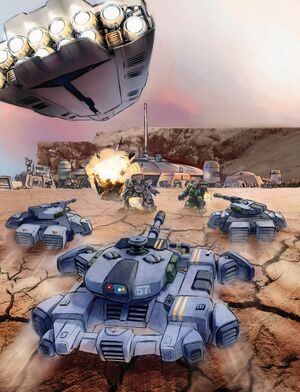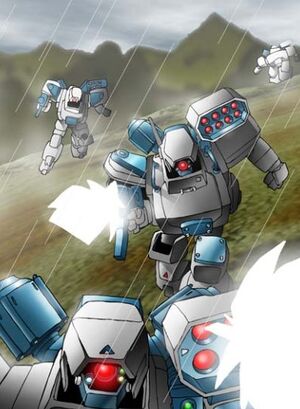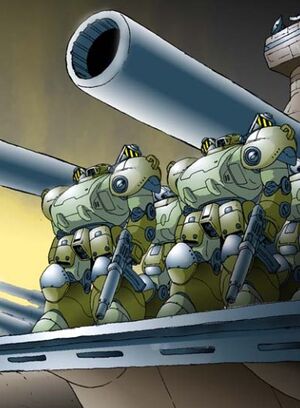War of the Alliance
In TN 1454 (A.D. 5790), an Earth-first government pulled back all its resources from the various colonies, leaving them to fend for themselves. In TN 1913 (A.D. 6118), it returned in force with the Colonial Expeditionary Force, strong with 400,000 highly trained men and supersoldiers (the GRELs), with the intent of reconquering those colonies.
The CEF expected little resistance, having assumed that Terra Nova would have been devastated by the departure of Earth many centuries ago. It never expected a planet with a strong technological civilization, and it certainly did not expect to encounter Gears, the characteristic humanoid combat units of Terra Nova.
Thus began the War of the Alliance, so named because it allied North and South against the invaders.
The Darkest Days
The Colonial Expeditionary Force’s plan was simple. They would establish a base of operations in an unchallenged Badlands region, and then overrun the industrial cores of Terra Nova’s poles, the Mekong Dominion and the United Mercantile Federation. In the opening seasons of the war, everything seemed to be going according to plan.
In the summer of TN 1913, the fleet landed over 400,000 troops along the equator. Their main base was in the Barrington Basin desert, allowing them to strike southward into the Mekong Dominion. The second main concentration was in the Western Desert, from where they could drive into the UMF. Sub-orbital transports also allowed the CEF to drop attack forces across the planet to target specific other cities. To cover the drive into the industrial regions, and to weaken Terra Nova in general, late 1913 and early 1914 saw a massive orbital bombardment of many city-states. This campaign crippled Terranovan military production, especially in the South.
The Badlands communities who saw CEF forces landing in their midst had little choice but to surrender, especially after the community of Mount Kiev was massacred for resisting in Summer of 1913. The CEF then drove towards its targets with devastating results. By the middle of 1914, the CEF had occupied Ngorongoro, Atsi and Yung An in the Mekong Domion, Mainz in the UMF, and laid waste to much of Ashington in the UMF. Other CEF units were driving into the Western Frontier Protectorate and some Republican border lands as well.
Faced with imminent defeat, Terranovan leaders had little choice but to put aside their differences. After a series of covert meetings organized by Nicosa Renault, a Judas Syndrome information broker, Terranovan forces were put under the unified command of Northern Field Marshal Anders von Breslau, assisted by Prefect Arland Longchamps of the Southern MILICIA. This political victory was counterbalanced by a serious setback when Paxton Arms, the globe’s largest weapons manufacturer and the owners of the independent Badlands city-state of Peace River, announced their neutrality in the conflict. Unable to bear the brunt of a CEF assault, they ceased production and decided to wait out the war cycles.
Terra Nova Fights Back
The CEF drive into the Terranovan industrial heartland eventually stalled because of the weakened CEF supply lines and the simple tenacity of the defenders. Supply became a serious problem for the invaders starting in TN 1914 when Terranovan engineers and scientists were able to devise a new breed of killer satellites and orbital drones to repel the Earth fleet. By specifically targeting the valuable Gateships, these thousands of satellites forced the fleet to withdraw from Terranovan orbit, depriving CEF ground troops of orbital artillery and drop-ship supply.
One the ground, the further the CEF pushed, the greater the resistance became. Knowledge of the ground and the presence of walker vehicles like Gears made all the difference in the Mekong Domion, where guerrilla warfare became the order of the day. The heroic deeds of the Mekong Peacekeepers in these days are still remembered today. The UMF Army raised the stakes when it opted to use weapons of mass destruction to slow the CEF advance. Detonating tactical nuclear weapons on its own turf, the UMFA slowed the CEF at the cost of its own nation.
By the end of TN 1914, the CEF’s blitz had become a war of attrition, one that would cost countless lives. TN 1915 was a long and bloody cycle, with many battles but few changes to the tactical situation. The most notable event happened in the Spring, when a CEF task force occupied Livingstone in the NLC, wiping out the Northern Guard’s Maüler Khans regiment in the process. The task force then tried to drive toward the Northern capital of Valeria, the loss of which could have crippled Terra Nova. Disaster was averted thanks to the efforts of the Guard’s Rising Cross regiment, which defeated the task force at great costs.
The Turning Point
By the beginning of 1916 it was becoming clear to CEF command that their ground forces were slowly becoming exhausted. They needed reinforcement and resupply and the Terranovans needed to be hit where they were weak. Braving the hail of killer satellites, the fleet returned to close orbit and dropped 80,000 fresh troops (under the command of Colonel Helena Agrippa) onto the Badlands city-state of Port Baja, the equator’s only space port. Von Breslau knew immediately that this was the breaking point of the war. His forces could not withstand the opening of another front, especially if the new CEF troops managed to coordinate with those already on the ground. They could not be allowed to get out of Baja.
The Second Western Armored Division (under the command of Brigadier Lang Regina), and the Republican Légion Noire (under the command of Prefect Kenichi Tanaka) were sent into Baja to get the job done. For most of the Spring, the two divisions hemmed the CEF task force and fought their way into the city. They used every ounce of firepower they could, faltering the city in the process. The battle was won, but at the cost of 100,000 Terranovan lives.
In the wake of the victory at Baja, Paxton Arms reentered the war effort. Over the Spring and Summer, it assembled and armed the Peace River Army, a rag-tag force made up of its own small military and the many partisan groups that had sprung up across the Badlands. The Peace River Army, although not large in number, would help tip the scales in favor of the Terranovan defenders.
Victory
The city-state of Westphalia in the Western Desert had, by the end of 1916, became a sort of neutral ground between opposing forces. As the CEF was pushed out of the UMF and Mekong Domion and the final drive into the Barrington Basin began, Westphalia became the site of secret negotiations between the defenders and the CEF. These discussions were nothing but secret meetings until the Winter of 1917, when Von Breslau himself pushed a landship fleet into the Barrington Basin and cut off the Western Basin Base (the CEF’s ground command post and the future sight of Port Arthur) off from the rest of the Expeditionary Force. When Terranovan forces rolled into the base itself, Von Breslau got what he wanted: an unconditional surrender.
The specific were worked out over the next two seasons as CEF forces were mopped up across the globe. Many CEF units were operating under radio silence and refused to accept that they had lost, continuing the fight long after the surrender was accepted. Most made their way to the Western Base, were officers and others began to be lifted into orbit to rejoin the fleet. The War officially ended on 9 Autumn 1917 with the signing of the Treaty of Westphalia. Mere weeks later, the CEF fleet vanished back toward Caprice.
The fleet had been severely damaged, however, and not enough ships remained to carry all the troops home. Over 100,000 CEF soldiers, most but not all GRELs, were abandoned on Terra Nova.




